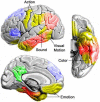The neurobiology of semantic memory
- PMID: 22001867
- PMCID: PMC3350748
- DOI: 10.1016/j.tics.2011.10.001
The neurobiology of semantic memory
Abstract
Semantic memory includes all acquired knowledge about the world and is the basis for nearly all human activity, yet its neurobiological foundation is only now becoming clear. Recent neuroimaging studies demonstrate two striking results: the participation of modality-specific sensory, motor, and emotion systems in language comprehension, and the existence of large brain regions that participate in comprehension tasks but are not modality-specific. These latter regions, which include the inferior parietal lobe and much of the temporal lobe, lie at convergences of multiple perceptual processing streams. These convergences enable increasingly abstract, supramodal representations of perceptual experience that support a variety of conceptual functions including object recognition, social cognition, language, and the remarkable human capacity to remember the past and imagine the future.
Copyright © 2011 Elsevier Ltd. All rights reserved.
Figures




References
-
- Locke J. An essay concerning human understanding. Dover; 1690/1959.
-
- Tulving E. Episodic and semantic memory. In: Tulving E, Donaldson W, editors. Organization of Memory. Academic Press; 1972. pp. 381–403.
-
- Allport DA, Funnell E. Components of the mental lexicon. Philos. Trans. R. Soc. Lond. B. 1981;295:379–410.
-
- Barsalou LW. Situated simulation in the human conceptual system. Lang. Cogn. Processes. 2003;18:513–562.
-
- Martin A, Caramazza A. Neuropsychological and neuroimaging perspectives on conceptual knowledge: an introduction. Cogn. Neuropsychol. 2003;20:195–212. - PubMed
Publication types
MeSH terms
Grants and funding
LinkOut - more resources
Full Text Sources
Medical
Miscellaneous

